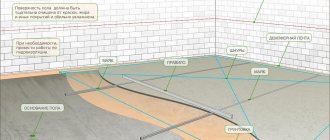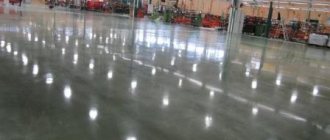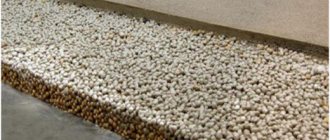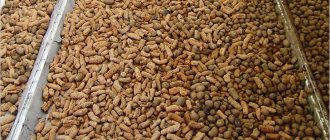If the floors in the house need not only leveling, but also insulation, the ideal way to do this would be to screed the floor with expanded clay - the technology for doing this work has long been proven and even has several options. Each of them has its own nuances that must be taken into account in order to obtain a high-quality surface. And the choice of method depends on the condition of the base and some other factors, which will be discussed below.
Expanded clay backfill can raise the floor to the desired level Source instrumentotido.ru
Advantages of expanded clay screed
If you compare expanded clay screed with traditional concrete, you can find only one serious drawback: the impossibility of laying a thin layer, which can be important for low ceilings. The disadvantages could also include lower strength than concrete, but it is quite sufficient for residential premises.
But screed with expanded clay has many advantages. These include:
- floor insulation on any base - soil, reinforced concrete slab, wooden flooring. And, as a result, increased comfort and reduced costs for heating the house;
- ensuring sound insulation between floors;
- the ability to level out any level differences;
Such a screed can cover differences of up to 10 cm or even more Source chonemuzhik.ru
- reducing the cost of leveling the base;
- the possibility of laying on insufficiently strong and reliable foundations, since expanded clay screed is much lighter than cement screed and therefore does not create a large load;
- the possibility of laying communications under the floor in a thick layer of screed.
All this together makes expanded clay rough coating much preferable to concrete. There is only one limitation for its use - this is the high probability of moisture getting into the thickness of the dry screed. That is why it is not recommended to install a water heated floor in it. Expanded clay gets along well with electric and infrared.
For reference! Expanded clay itself is not afraid of water and is not destroyed by its influence. But stagnation of moisture is dangerous due to the appearance of dampness in the house and the formation of mold.
In what cases is monolithic expanded clay concrete effective and in demand?
The technology for forming strong and lightweight foundations based on monolithic expanded clay concrete is indispensable when performing construction work. It is in demand in a number of situations:
- if it is necessary to fill significant volumes of mortar in rooms with height differences of more than 150 mm;
- when forming foundations in old buildings equipped with wooden floors.
The use of concrete mortar in these cases can cause damage to floors that are not designed for increased loads.
Varieties of expanded clay
Floor screed with expanded clay is performed in different ways, which can be divided into dry, wet (traditional) and combined. For each of them, the material is selected individually. More on the methods below, but for now let’s figure out what expanded clay is and what properties and characteristics it has.
Expanded clay granules: dense on the outside and porous on the inside Source ec-nn.ru
The basis of the material is clay with special additives. The raw material is subjected to high-temperature firing, as a result of which it swells with the formation of many small closed voids inside and a dense crust on the surface. This porous structure allows the use of expanded clay as insulation with unique properties. With a sufficiently high density and strength, it is lightweight and resistant to moisture.
Depending on the production method, shape and size of individual particles, the material is divided into 3 types:
- expanded clay crushed stone, the main difference of which is the irregular shape of particles 0-40 mm in size, obtained by grinding large stones;
- expanded clay sand, consisting of round granules less than 5 mm in diameter;
- Expanded clay gravel is also a mixture of oval or round granules with a diameter of up to 40 mm. It can be homogeneous, from granules of 5-10, 10-20 or 20-40 mm, or it can consist of elements of different sizes.
Some types of expanded clay Source 1nerudnyi.ru
Note! Grain sizes and other characteristics of the material are regulated by GOST 32496-2013. Manufacturers producing it according to their own specifications cannot guarantee quality.
This bulk material also differs in density, which depends on the size of the granules and voidness. The lower these indicators, the greater the weight.
For thermal insulation, expanded clay flooring in the form of crushed stone or gravel is used. Sand is not suitable for this, as it has a high density. It is used when it is necessary to level bases with large differences in level or damaged surfaces as a material that gives less shrinkage.
Semi-dry method
The peculiarity of the method, which can provide a reduction in work time, is that expanded clay is added directly to the sand concrete solution.
Work progress:
- The concrete mixer is filled with expanded clay, then water is added so that the material absorbs it.
- Sand concrete is added and the ingredients are mixed until a homogeneous mass is obtained.
- Reinforcement is made with mesh.
- Fill the working surface with the prepared solution. The hardening surface should be periodically moistened and protected from shifting.
The semi-dry method technique requires the installation of a concrete base under a layer of expanded clay. It is easy to install and allows you to form the screed in layers using existing volumes of working composition. The consumption of materials will be 1:1, take 60 cm3 of expanded clay - 12 bags, plus 60 cm3 of sand concrete solution - 27-31 bags, 20 m2 of mesh for reinforcement. The dry type of screed for the base is made without the use of cement mortar.
Methods for installing expanded clay screed
Expanded clay for leveling and thermal insulation of bases can be used in bulk form or as a filler for a pouring mixture. Depending on this, the technology of work also changes.
Wet method - traditional screed
Expanded clay concrete screed is made in exactly the same way as a classic screed, from a sand concrete mixture. It’s just that not ordinary crushed stone or gravel is used as a filler, but expanded clay. It allows you to seriously lighten the load on the floors when the thickness of the screed is needed: about 50 kg for every square meter with a thickness of 5-6 cm.
Finished rough coating Source chudopol.ru
See also: Catalog of house projects presented at the Low-Rise Country exhibition.
In this case, the fractionation of the material is not particularly important, since the voids will be filled with sand, and all components of the solution will be bound into a monolith. Therefore, you can take both crushed stone and gravel, focusing on the availability and cost of the filler. Typically, crushed stone is cheaper due to its lower density and weight.
It is also worth considering that the smaller the size of the aggregate granules, the smoother the surface will be. The layer with large crushed stone will probably have to be leveled additionally with cement mortar, making a finishing screed. A layer of gravel may well serve as a ready-made base for laying tiles, but you cannot lay linoleum or laminate on it - you will also need to level the surface.
Advice! When using coarse aggregate for screeding on the ground, its surface must first be leveled and compacted, without leaving significant unevenness and dips.
The composition of expanded clay concrete, the proportions per 1 m3 depend on the brand of cement used and the requirements for the strength of the base. For a house or apartment, an approximate ratio of M400 cement, sand and expanded clay is usually used: 1: 3: 2. This composition provides a grade of screed M50-M100 sufficient for domestic conditions, taking into account the laying of the finished floor covering.
Mixes according to various recipes
Private construction is not always located in close proximity to an industrial enterprise, when you can order, for example, large-porous expanded clay concrete or ready-made blocks.
Often the optimal solution lies in the production of the necessary building materials directly on the site.
- To do this, you will need a 200 liter concrete mixer. It can be purchased at a specialized store or made with your own hands from an old barrel;
- Container for receiving the finished solution;
- Vibrating machine, if you plan to produce blocks;
Forming flask for producing blocks
- To prepare 100 kg of expanded clay concrete mixture, which will then be used for the production of blocks, you will need:
- 9.21 kg of cement;
- 54.5 kg of expanded clay;
- 27.2 kg of sand;
- 9.09 liters of water.
This is the standard dosage.
Video description
You can study the technology of installing a screed made of expanded clay concrete using the video:
The work consists of several stages.
- First, the level to which the floor rises is marked along the walls. To do this, it is most convenient to use a laser level.
- After removing the old floor covering and clearing away the debris, the holes in the ground are filled and compacted, large cracks, gaps along the walls and joints between the slabs are sealed - the preparatory work depends on the material and condition of the base.
- The next stage is waterproofing. It is needed so that moisture does not leave it during the hardening process of expanded clay concrete. And also to prevent leaks from wet mortar to the lower floors. In the case of a ground screed, the waterproofing also serves as a barrier to groundwater. It is made from thick film, roofing felt or fiberglass, always laying the material with an overlap of at least 10 cm and gluing the joints with tape. Concrete bases can be insulated with liquid compounds - waterproofing, liquid rubber, etc. The waterproofing layer should be continuous and extend vertically onto the walls above the marking level.
Waterproofing under screed Source sam-sebe-dizainer.com
See also: Catalog of companies that specialize in the design and construction of turnkey country houses.
- If electrical cables are laid along the floor, they are also wrapped in film and wrapped with tape.
- Next, the beacons are installed, fixing them with cement mortar or alabaster. The distance between beacons should be no greater than the length of the rule.
- Along the entire perimeter of the walls along the marking line, damper tape is glued or secured in any other way. It neutralizes the thermal expansion of the screed and serves as sound insulation. You can use either ready-made self-adhesive tape or other suitable materials - for example, strips of polystyrene foam.
- Then expanded clay concrete is prepared, the proportions of which are selected in accordance with the strength requirements. In the case of an insulating screed and laying a hard floor covering on top of it, it is allowed to double the amount of expanded clay.
Proportions of components for obtaining a solution of different brands Source remoo.ru
- When making a solution, it is recommended to first fill the expanded clay with water so that it absorbs moisture and does not float to the surface of the screed and does not pull it out of the solution. Then add the remaining components - cement and sand or a ready-made sand-cement mixture.
- If the thickness of the screed exceeds 60-100 mm, then it is poured in 2 layers with a minimum soak time between layers. It is best to divide the room into squares and fill each area in 2 steps, then move on to the next one.
- If the screed is without a leveling layer, then the solution is pulled out according to the beacon rule. In the case of a cement screed, leave space for it - at least 2-3 cm to the upper level of the beacons, and the expanded clay concrete is leveled by eye.
- After the initial setting of the solution, the beacons are removed, and the resulting depressions are sealed with fresh solution.
Beacons are removed until the solution has completely set Source polonest.ru
What will you need when working?
- Container for stirring the solution.
- Level (any).
Level
- Rule.
- Stirring device (mixer or stirrer).
- Net.
- Lighthouses.
- Polyethylene.
- Master OK.
- Scotch.
- Large needle roller.
- Expanded clay.
- Cement, sand or ready-made mixture.
- Mastic.
- Water.
- Plaster or alabaster.
Video description
The entire process from backfilling to laying the coating is shown in the video:
Advice! It is better to start backfilling from the far wall and move towards the exit, and laying gypsum fiber boards in the reverse order. But you can carry out the installation in small sections or move along a temporary gypsum fiber board flooring thrown onto the expanded clay.
Combined method - type-setting screed
Something in between the described options is a screed on expanded clay, poured onto the base in a thick layer. To ensure effective thermal insulation, the thickness of the backfill layer must be at least 100 mm and consist of gravel of different fractions. If only leveling with raising the floor level is required, the layer of dry expanded clay may be smaller, and the backfill may consist of fine crushed stone and sand.
Installation of a wet screed over a dry screed Source www.baurum.ru
So, screed with expanded clay – the technology for its production with all its variations:
- as usual, the first step is to mark the level and prepare the base;
- expanded clay is poured and distributed so that there is room for a cement screed (usually at least 20-30 mm);
- so that the backfill does not float up into the screed, the expanded clay layer is filled with cement laitance - a liquid solution that should seep between the granules and hold them together;
- a day later, beacons for a wet screed are installed on the set layer;
- Between the layers you can lay a reinforcing mesh, which is important for large areas, or a thick polyethylene film, which will prevent the expanded clay from sucking water out of the solution. In this case, there is no need to spill the backfill with liquid solution.
Wet method
The mixture will be made using expanded clay, the ratio will be 2:1. It should turn out that for a volume of expanded clay of 80 cm3 you will need 80 bags and 0.4 m3 of dry composition - 21 bags of sand concrete. It is recommended to take a large container for kneading.
Work progress:
- Determination of differences in the height of the base, and determination of the maximum submerged area.
- Expanded clay is poured in and distributed evenly.
- Expanded clay granules are impregnated with a solution of cement laitance.
- The sand concrete solution is poured and leveled; it is recommended to start from a remote area of the room and then move to the exit.
- Next, you will need to maintain favorable humidity conditions by periodically moistening the surface layer.
Do not expose a massive structure to mechanical stress for the first 24 hours; it is strictly not recommended. When the milk has hardened, you can begin further repair work. Qualified builders advise protecting the formed surface from mechanical damage for 4 weeks from the moment of pouring.
Useful advice from professionals
A few recommendations from experts:
- To obtain the most durable base, preference is given to material with a granule diameter of 5–20 mm. To make the screed more durable, several types of fractions are mixed.
- The higher the strength, the lower the heat transfer of the screed. Expanded clay retains more heat with lower declared strength.
Leveling the floor with expanded clay is quite simple. It is quite easy to carry out the work even alone, unlike using concrete mortar. Before leveling, you need to stock up on all the necessary tools and materials.
Profitable purchase from AlfaCem
You can get the building materials described above from us. We will help you purchase high-quality products from trusted suppliers in the shortest possible time with subsequent delivery throughout the Central Federal District of Russia.
Leave a request via the feedback form or call us directly. Responsible and competent managers will easily answer any question that arises. They are:
- explain the main technological nuances;
- talk about modern construction techniques that you can use by purchasing our products;
- They recommend convenient services for making payments for orders, etc.
By participating in promotions and activating discounts, the cost of building materials is significantly reduced, which you also have the right to take advantage of. Waiting for you!
Scope of application
The scope of application of expanded clay is multifaceted:
- to reduce screed pressure on concrete bases;
- to reduce the load on the screed, for example, when the floor is subject to significant weight loads (garage, industrial premises);
- for installation of heated floors (convenience of placing warm water communications directly on the expanded clay layer);
- for leveling surfaces when it is necessary to reduce concrete consumption due to bulk material.
Attention
Medium and large fractions are used if it is not necessary to create a solid foundation on the surface. Granules are used when installing self-leveling floors or when covering with gypsum fiber sheets.
Price
The price of expanded clay is influenced by : the size of the fractions, the type of its packaging and packing; expanded clay is sold cheapest in bulk:
- with a fraction size of 0.1-5 mm, about 2500 per 10 cubic meters;
- with a fraction size of 5-10 mm, about 2100 per 10 cubic meters.
In bags packed in 50-meter cubes, the price will be higher, but the material will be cleaner and will not contain impurities and dust.
Leveling the floor according to the beacons. Read about it here. And this article talks about leveling the floor using beacons.
Here you will find many more useful articles about fences.











